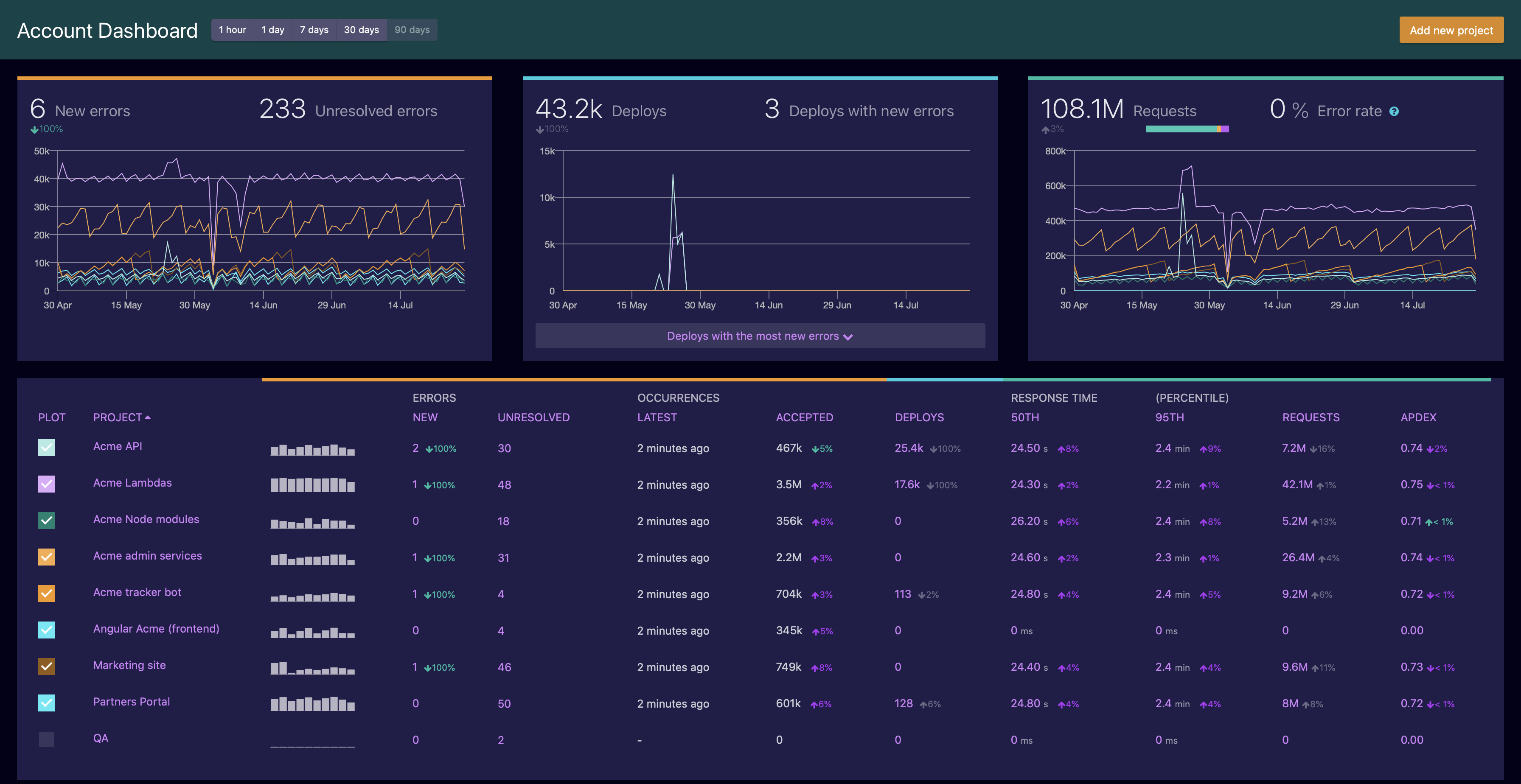Airbrake
About Airbrake
Airbrake Pricing
30-day free trial with FREE unlimited errors and performance events. Paid plans starting at $19.00 per month.
Starting price:
$19.00 per month
Free trial:
Available
Free version:
Available

Most Helpful Reviews for Airbrake
1 - 5 of 30 Reviews
Bryan
Verified reviewer
Design
Used daily for more than 2 years
OVERALL RATING:
5
EASE OF USE
5
VALUE FOR MONEY
5
CUSTOMER SUPPORT
5
FUNCTIONALITY
5
Reviewed March 2018
My Favorite Error Tracker for Webapps
Airbrake has made error tracking easy for us and I enjoy that the interface and feature set continue to improve over the years.
PROSAirbrake is one of the items on our checklist to setup with every new webapp we create. The setup is fast and it provides immediate value. Being able to receive an email for a new error that comes in is indispensable.
CONSI would like to see Airbrake integrate with Kanbanery as that is our agile project management tool of choice. It does already integrate with Trello and Pivotal Tracker. Finally, while we use Airbrake on all of our apps, we do not always upgrade to a paid plan as it is simply more than we need. If Airbrake had one more lower tier paid option, then we would consider upgrading more apps to paid plans.
Rich
Internet, 1,001-5,000 employees
Used daily for more than 2 years
OVERALL RATING:
5
EASE OF USE
5
CUSTOMER SUPPORT
5
FUNCTIONALITY
4
Reviewed April 2017
Airbrake is a great error monitoring product
We rely on Airbrake for additional production and test environment monitoring of app exceptions. By linking Airbrake error alerts to HipChat notifications, we get great high-level alerts whenever an error happens, right in our team chat room. It's easy to drill down into the error details with the UI. We also use the Comments feature of the Airbrake errors to reduce bystander effect among team members -- no comment means nobody triaged the issue.
PROSGreat UI, easy to drill into the errors. It's great how they roll up errors of similar types intelligently. The "Occurrences" view is especially helpful, to know which errors are infrequent and which deserve higher attention.
Matthew
Information Technology and Services, 501-1,000 employees
Used more than 2 years
OVERALL RATING:
4
EASE OF USE
5
VALUE FOR MONEY
4
FUNCTIONALITY
4
Reviewed July 2020
A Long Running Service For Exception Reporting
We used Airbrake for many years and found it easy to integrate it into projects with Ruby on Rails and other popular frameworks. Over time the company has shifted more towards using Rollbar which is compatible with Airbrake clients but had more advanced server side aggregation of errors and other search / filtering features that came in handy for us.
PROSIt is easy to setup with popular frameworks like Ruby on Rails and Python. Its compatible with similar products which helps avoid vendor lock-in. The service has been running a long time and has established a track record of being reliable.
CONSIt is a bit light on features compared to some of the newer competitors. The main decision points for me would be cost and how easily the UI allows you to access the information you need. I think there are competitors with a better UI and the pricing would probably depend on your team size.
Spencer
Used free trial
OVERALL RATING:
5
EASE OF USE
5
VALUE FOR MONEY
5
CUSTOMER SUPPORT
5
FUNCTIONALITY
4
Reviewed February 2017
Powerful and easy to use! Plus, a great ROI
Airbrake has been used by other teams in my organizations for quite some time. My team and I were building a new Rails application and we decided to include Airbrake for error reporting. Using Airbrake was one of the best decisions we made and here's why: tl;dr - Installation, configuration, and integration were all painless. My only request is to expand supported integrations to more and different systems (New Relic, in our case). 1) App integration: "Installing" Airbrake in our Rails application was as simple as adding an entry in our Gemfile and creating an initializer for configuration. And that's it! 2) Configurability: As I just mentioned, configuration is available in your application. However, configuration "points" also exist in Airbrake at the account, project, and user levels. All these configurations work together seamlessly. This has allowed us to get the right notifications to the right people at the right time and avoid the "notification overload" that can come with other monitoring solutions. 3) External Integrations: Airbrake supports integration with many popular issue trackers and team communication solutions. We integrate Airbrake with JIRA and Slack, so there was no need to introduce a new tool to our daily workflow. However, I would like to see integration support expanded. For example, the integration with New Relic requires a third party solution that ended up not working for us. Airbrake does support webhooks, so we're still able to integrate with systems that are not supported OoTB. 4) Documentation: Setting up Airbrake and integrating it into our ecosystem has required little to no guesswork on our part.
David Eugene
Verified reviewer
Outsourcing/Offshoring, 51-200 employees
Used daily for less than 6 months
OVERALL RATING:
4
EASE OF USE
4
FUNCTIONALITY
5
Reviewed November 2018
Trace logs galore
since we don't have the luxury of time to debug and traceback every issue happening to our multiple sites, airbrake cuts so much time debugging and that time saved is better spent on working on a fix right away, sometimes even before the users notice anything.
PROSOur Devs love to sift through the detailed logs, if they put the airbrake code in their source properly. For me as QA, i can also traceback what scenario triggers a particular error log. if we don't have enough time to go inside airbrake, we can have email/slack alerts set up for specific issues, from specified environments. mute an expected alert is also possible, if needed. The dashboard is available with graphs and statistical data.
CONSprobably too much information at times, like for a simple error message on the UI, there maybe hundreds of lines of backtrace info being sent. maybe not a very bad thing to have, but when the issues come in all at once, it's overwhelming that the users don't want to be inside the airbrake site anymore and just wait for user feedback, then check airbrake as last resort.





